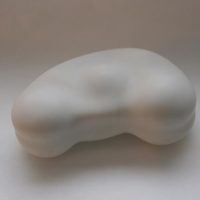art nexus, 75, vol. 8, december 17th, 2009
-
k (kidney)
2009 Carrara marble 8 x 4 x 3 in.
Photography by Frederico Sève
By JOHN ANGELINE — Organs without Bodies marks the New York debut for Brazilian-born artist Angela Freiberger, and the artist has presented an exhibition that is grandiose in its own modest way.
Utilizing a sculptural training that she received in Italy, the artist has carved a series of objects in white-and-grey Carrara marble, many of which are placed upon pedestals that have been arranged in a grid, although some are grouped on a separate shelf. Most of the pedestal pieces are in the form of vessels—basins or urinals—with various organs and internal body parts carved in relief or imprinted on them. The shelf sculptures tend to be somewhat abstracted but otherwise independent organs. The voids of the vessels suggest empty bodies; however, the organs are usually carved on the external side of each piece, putting them on the “skin” or otherwise outside of the “body”. The duality between internal and external, absence and presence is enhanced by the vessel-less organs on the shelf. The pedestal grid also includes some pedestals without sculptures on them, presumably creating spaces for the viewer’s own body to occupy and become part of the transference.
This group of sculptures, inorganic and inert, is further suggestive of the body through a series of photographs in which each marble piece is paired with the artist’s own body. In many of these, the artist’s body is posed with the sculpture in ways that exploit the voids of each vessel. Despite being still images there is the element of the performative in each photograph, with the warm brown tones of the artist’s body in strong relief of the cool whites of the marble, such as we can see in Urinal with Ribs and Butt 2. It is also through the engagement with the body in these pictures that the sculptures shift in semblance from Brancusi-esque modernist abstractions to ancient indigenous basins and carvings.
A third component of the project was a video projection entitled Dual. Garishly bright and colorful alongside the cool whites, greys, and pinks of the sculptures, the floor-projected video provides graphic fields upon which are imposed paired bodies dancing or in play. While superficially incongruous to the rest of the artwork, this video piece continues Freiberger;’s theme of duality and the body and its other, a concept borrowed from Artaud and shared by such psychological constructions as the doppelganger.
There is an admirable, almost overreaching scope to this project, almost as if Freiberger was self-conscious about making a Big Statement in her new New York Gallery debut. Certainly combining sculpture, video, photography and performance in a project that was influenced by Deleuze, Artaud, Freud, and Duchamp is nothing if not ambitious. Indeed, given the dates of the various components of this installation, Freiberger either worked on this meta-project for years or she and the curator cobbled together an array of works to make a new one; in some ways, the sum does not seem to be equal to its parts. The most successful component is the photographs, which fuse together the various aspects of the project and best illustrate the many dualities that Freiberger wants to invoke. In the future she may want to temper her ambitions a bit and edit her choices, demonstrating that less can still be more.
